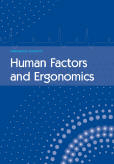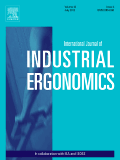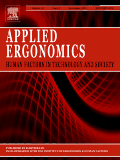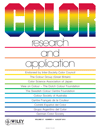
International Journal of Human Factors and Ergonomics
Scope & Guideline
Empowering Research to Transform User Experiences
Introduction
Aims and Scopes
- User-Centered Design:
The journal emphasizes the importance of designing systems and products with the end-user in mind, ensuring that usability and user experience are prioritized in the development process. - Cognitive Ergonomics:
Research in this area explores how cognitive processes affect human interaction with systems, including decision-making, attention, and memory, often utilizing methodologies such as eye-tracking and cognitive workload assessment. - Occupational Health and Safety:
A significant focus on ergonomics interventions and assessments in various occupations, aiming to reduce workplace injuries and enhance productivity through better design and practices. - Assistive Technology:
The journal publishes studies on technologies aimed at supporting individuals with disabilities, addressing usability and effectiveness to improve their quality of life. - Innovative Ergonomic Solutions:
Research that investigates new ergonomic tools, products, and methodologies, often through case studies or systematic reviews, to address specific industry needs.
Trending and Emerging
- Wearable Technology and Monitoring:
The increased focus on wearable technology for monitoring physical posture and workloads reflects a growing interest in real-time data collection and its application in improving ergonomics in various settings. - AI and Cognitive Load Assessment:
Recent studies emphasize the role of artificial intelligence in enhancing user experiences and managing cognitive loads, showcasing the intersection of technology and human factors. - Ergonomics in Emerging Environments:
Research exploring ergonomics in novel contexts, such as the industrial metaverse and remote work settings, indicates a trend towards understanding human factors in increasingly digital and flexible environments. - Health and Performance in Specific Populations:
There is a notable increase in studies focusing on the ergonomics of specific groups, such as older adults and individuals with disabilities, addressing their unique challenges and needs. - Macroergonomics and System-Level Approaches:
Emerging themes include macroergonomics, which considers the interaction of humans within larger systems and organizational contexts, reflecting a shift towards more holistic approaches in ergonomics research.
Declining or Waning
- Traditional Ergonomic Assessments:
There has been a noticeable decrease in studies focused solely on traditional ergonomic assessments, as researchers increasingly integrate more dynamic and innovative approaches to ergonomics. - Generalized Workplace Studies:
Research that broadly examines workplace conditions without a specific focus on unique ergonomic interventions or technologies is becoming less common, as the field moves towards more targeted and specialized studies. - Static Design Evaluations:
The trend is shifting away from static evaluations of designs towards more iterative and user-centered approaches, reflecting a broader understanding of the need for adaptability in ergonomic design.
Similar Journals

INTERNATIONAL JOURNAL OF INDUSTRIAL ERGONOMICS
Driving research for a healthier workforce.INTERNATIONAL JOURNAL OF INDUSTRIAL ERGONOMICS, published by Elsevier, is a premier scholarly outlet dedicated to advancing the fields of human factors and ergonomics, as well as public health, environmental, and occupational health. With an impressive Q2 ranking in both relevant categories, this journal serves as a crucial forum for researchers and professionals seeking to share and access high-quality research aimed at optimizing human performance in industrial settings. The journal has been at the forefront of ergonomic research since its inception in 1986, fostering a rich discourse across disciplines and providing invaluable insights that bridge science and practice. While open access options are not available, the journal is widely accessible through institutional subscriptions. With a Scopus Ranking of #118/665 in Public Health and a #10/46 position in Human Factors, it caters to a diverse audience interested in the latest findings and applications in ergonomics, ensuring its relevance in a rapidly evolving field. Join a community dedicated to enhancing workplace safety and efficacy through rigorous research and innovative methodologies.

International Journal of AEROSPACE Psychology
Navigating the Psychology of FlightInternational Journal of Aerospace Psychology is a premier publication dedicated to advancing the interdisciplinary field of aerospace psychology, addressing the cognitive, emotional, and behavioral aspects of human interaction with aerospace environments. Published by Taylor & Francis Inc., this journal occupies a pivotal position in the academic landscape with its Q2 ranking in Aerospace Engineering and Q3 rankings in Applied Psychology and Computer Science Applications, reflecting its commitment to high-impact research. With an ISSN of 2472-1832 and E-ISSN of 2472-1840, it is accessible through open access options, ensuring that cutting-edge research reaches a wide audience of researchers, practitioners, and students. Covering a broad scope from psychological implications in aerospace systems to educational methodologies in this domain, the journal spans converged years from 2017 to 2024. The Scopus rankings further reinforce the journal's significance, with notable standings within multiple categories, making it an essential resource for those at the intersection of aerospace, psychology, and technology.

Journal of Usability Studies
Advancing user experience through innovative research.The Journal of Usability Studies, published by the USERS EXPERIENCE PROFESSIONAL ASSOCIATION, is a pivotal platform for researchers and professionals dedicated to advancing the field of usability and user experience design. With an ISSN of 1931-3357, this journal offers a collection of peer-reviewed articles that explore innovative methodologies, emerging technologies, and applied research in usability studies. Though it operates under a traditional access model, the journal remains dedicated to fostering a detailed understanding of how users interact with systems and products. The Journal of Usability Studies is instrumental for those aiming to enhance user satisfaction through research-backed insights, making it a vital resource for academics, practitioners, and students seeking to contribute to the evolving discourse in human-computer interaction and usability engineering.

Journal of Health and Safety at Work
Empowering safety and health research for a better tomorrow.The Journal of Health and Safety at Work, published by the Iranian Occupational Health Association, is a vital resource for researchers, professionals, and students engaged in the fields of occupational health, safety, and environmental management. With an ISSN of 2251-807X and E-ISSN 2383-2088, this Open Access journal has been dedicated to disseminating knowledge since 2012, ensuring that critical research is accessible to a global audience. The journal’s scope encompasses a diverse range of topics including human factors and ergonomics, safety research, and public health, with a focus on enhancing workplace safety and environmental standards. Although currently positioned in the Q4 category across various disciplines within safety and health research, the journal offers a unique platform for emerging studies and innovative practices, making it a significant contributor to the discourse in these fields. The journal's commitment to open access aligns with the growing trend of transparent scholarship, thus facilitating the sharing of vital insights to improve workplace health and safety outcomes. Researchers aiming to publish groundbreaking studies in this pivotal area will find the Journal of Health and Safety at Work an indispensable avenue for advancing knowledge and fostering professional collaboration.

APPLIED ERGONOMICS
Shaping the Future of Ergonomics with Groundbreaking ResearchWelcome to Applied Ergonomics, a premier journal dedicated to advancing knowledge and practice in the multidisciplinary field of ergonomics and human factors. Published by Elsevier Science Ltd, this esteemed journal features a diverse range of research covering critical aspects of physical therapy, human factors, safety, and engineering. With an impressive impact factor and consistently ranked in the Q1 category across multiple domains—including Engineering, Human Factors and Ergonomics, and Safety—Applied Ergonomics serves as a vital resource for researchers, professionals, and students aiming to enhance user experience and optimize workplace safety. With its extensive historical archive dating back to 1969 and continuing through 2025, this journal encourages the dissemination of innovative applications and research findings that contribute to the ergonomics body of knowledge. For those interested in cutting-edge research that directly impacts health and safety practices, Applied Ergonomics is the authoritative source.

Management and Production Engineering Review
Advancing Knowledge in Management and Production EngineeringManagement and Production Engineering Review, published by the Polish Academy of Sciences, stands as a pivotal platform for disseminating research in the realms of management, production engineering, and related fields. This journal operates under a commitment to providing high-quality, peer-reviewed articles that explore a range of impactful topics including business management, industrial engineering, and technology innovation. With a steady convergence period from 2012 to 2013 and continuing until 2024, it has earned a commendable position in the academic landscape, achieving a Q3 ranking across several critical categories like Business and International Management, Organizational Behavior, and Management Science. Its Scopus rankings reflect its emerging influence, particularly in the Industrial and Manufacturing Engineering sector, where it holds a rank of #173 out of 384. Although it does not offer an Open Access option, the journal remains a vital resource for academics and professionals seeking to expand their understanding and contributions to contemporary practices in management and production engineering.

International Journal of Social Robotics
Connecting Disciplines to Shape the Future of RoboticsThe International Journal of Social Robotics, published by Springer, stands at the forefront of interdisciplinary research, exploring the intersection of artificial intelligence, robotics, and social sciences. With an impressive impact factor and ranked in the Q1 category across multiple fields—including Computer Science, Control and Systems Engineering, and Social Psychology—this journal provides a premier platform for scholars and practitioners to disseminate their findings and engage in critical discussions about the role of robotics in society. Since its inception in 2009, the journal has frequently featured innovative studies that address vital issues such as human-robot interaction, ethical considerations in automation, and the societal impacts of robotic technologies. While it currently operates under a subscription model, its rigorous reviews and high-ranking publications make it an essential resource for anyone interested in the transformative power of social robotics. For those dedicated to advancing knowledge in this dynamic field, the International Journal of Social Robotics serves as an indispensable reference point.

Applied Clinical Informatics
Advancing patient outcomes with cutting-edge informatics solutions.Applied Clinical Informatics is a leading journal dedicated to the expanding field of health informatics and its applications within clinical settings. Published by GEORG THIEME VERLAG KG in Germany, this journal serves as a pivotal platform for researchers and professionals engaged in the integration of technology and healthcare, aiming to improve patient outcomes through innovative informatics solutions. With a solid Q2 ranking in multiple disciplines including Computer Science Applications, Health Informatics, and Health Information Management, it reflects its prominent position in the academic landscape. The journal provides accessible content while fostering dialogue on key issues and advancements in clinical informatics. Covering a wide array of topics from data management to e-health applications, Applied Clinical Informatics is essential reading for those looking to stay attuned to the latest research and developments from 2009 to 2024, enriching the knowledge base of students, professionals, and researchers worldwide.

COLOR RESEARCH AND APPLICATION
Illuminating Innovations in Color Science.COLOR RESEARCH AND APPLICATION is an esteemed journal dedicated to the exploration of color science, including its applications in various fields such as chemistry, human factors, and ergonomics. Published by WILEY, this journal has been a vital resource for both researchers and professionals since its inception in 1976, with a commitment to disseminating cutting-edge research and innovative methodologies. With an impact factor that reflects its significance in the academic community, COLOR RESEARCH AND APPLICATION ranks in the Q2 quartile across multiple categories, including Chemical Engineering, General Chemistry, and Human Factors and Ergonomics, illustrating its interdisciplinary importance. As a premier publication, it serves to bridge the gap between theoretical developments and practical applications of color science, thereby catering to a diverse readership that includes students, industry practitioners, and esteemed researchers. The journal offers a wealth of articles that not only enrich the understanding of color but also contribute to advancements in technology and human experience, ensuring its pivotal role in shaping future developments in the field.

Indian Journal of Occupational and Environmental Medicine
Advancing Knowledge in Occupational and Environmental HealthIndian Journal of Occupational and Environmental Medicine, published by Wolters Kluwer Medknow Publications, is a pivotal resource in the field of public health, focusing on the critical intersections of occupational safety and environmental health. With the ISSN 0973-2284 and E-ISSN 1998-3670, this journal has been a beacon of knowledge since its inception in 1999 and continues to influence scholarly discourse through its convergence years culminating in 2024. Recognized for its contribution to the field with a 2023 Scopus categorization of Q3 in Public Health, Environmental and Occupational Health, it has secured its place among the top journals, ranked #453 out of 665 within its specialty, reflecting a respectable 31st percentile. While it operates on a subscription basis, the journal ensures comprehensive coverage of significant research, thereby enhancing occupational health practices and environmental health policies. It serves as a vital platform for researchers, professionals, and students dedicated to advancing knowledge and improving outcomes in these crucial areas of health. The journal's commitment to excellence is evident as it continues to cater to a diverse readership from its base in Mumbai, India.